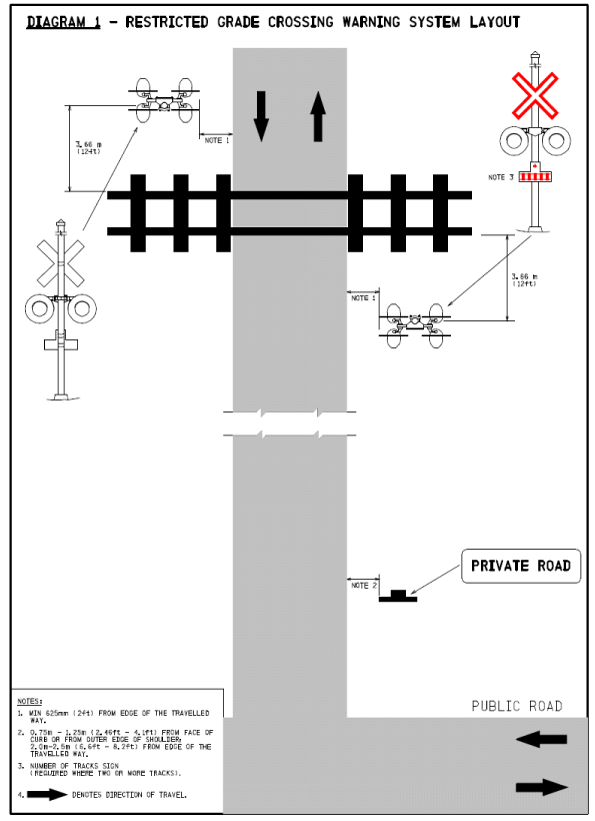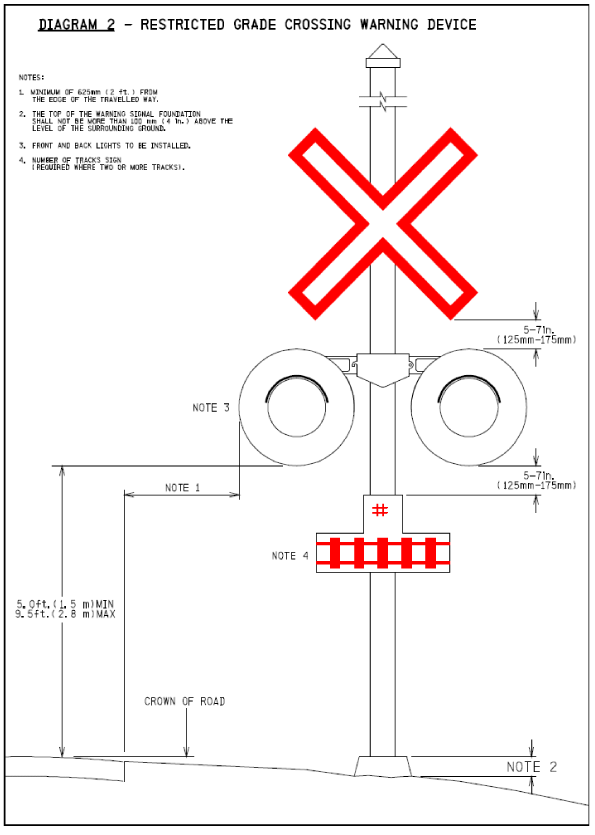All new grade crossings constructed after 2014, as well as existing crossings with new installations, must comply with Appendix B of the Grade Crossing Standards.
TC E-52, October 28th, 2010
Table of Contents
- 1. Purpose
- 2. Definitions
- 3. Relationship to Other Applicable Engineering Standards
- 4. Warning System Design
Diagrams
1. Purpose
1.1 These engineering standards provide the design requirements for grade crossing warning systems to be used at certain restricted crossings where there is not full control over crossing users.
2. Definitions
AREMA: American Railway Engineering and Maintenance of Way Association.
AREMA C&S Manual: Communications and Signals Manual of Recommended Practice published by AREMA, as amended from time to time.
Grade Crossing: A road crossing whose road passes across a line of railway at grade.
Restricted Grade Crossing: A grade crossing that is not an unrestricted grade crossing.
RTD10: Road/Railway Grade Crossings: Technical Standards and Inspections, Testing and Maintenance Requirements, established by the Department of Transport, as amended from time to time.
Unrestricted Grade Crossing: A public grade crossing or a grade crossing whose road is one of the following:
- a recreation road or trail or a pedestrian or bicycle path maintained by a club, association or other organization, including a snowmobile or hiking trail;
- a road or a pedestrian or bicycle path of a commercial or industrial establishment, including a business operated from a residential or farm property, that is used in connection with the establishment by persons other than employees of the establishment;
- a road that serves three or more principal residences;
- a road that serves three or more seasonal residences access to which is not controlled by a gate equipped with a lock;
- a road that connects two public roads; or
- a road maintained by a resource company such as a company involved in forestry or mining activities.
3. Relationship to Other Applicable Engineering Standards
3.1 All of the elements associated with grade crossing warning systems described in these engineering standards shall be designed in accordance with RTD10 and the AREMA C&S Manual requirements for Highway Rail Grade Crossing Warning Systems except when in conflict with these engineering standards in which case these engineering standards will take precedence.
4. Warning System Design
General
4.1 Grade crossing warning system installations for restricted grade crossings shall be designed and installed in accordance with diagrams 1 and 2 except where the installation cannot be so located due to local conditions, in which case an alternative arrangement providing an equivalent level of safety shall be used. Diagrams 1 and 2 form part of these engineering standards.
Operating Requirements
4.2 Battery backup for a minimum of 24 hours shall be provided.
4.3 Power monitor lights shall be provided.
Signal Requirements
4.4 Installation shall not require gates.
4.5 Height of the light unit may be different than AREMA or RTD10 so as to improve conspicuity.
4.6 Signal mast may be located closer to the roadway than AREMA or RTD10 so as to improve conspicuity.
4.7 Installation shall not require a bell or other audible device.
4.8 Installation shall not require standby control equipment.
4.9 Design approach warning time shall be calculated in accordance with the requirements of RTD10.
Signage Requirements
4.10 Information sign indicating the crossing ID or location and a number to call in the event of an emergency shall be located at each installation.
4.11 Private Road sign shall be posted at appropriate road approaches to the crossing as indicated in diagram 1.
Diagram 1: Restricted Grade Crossing Warning System Layout
Notes:
- Min 625mm (2 ft) from edge of the travelled way.
- 0.75m - 1.25m (2.46ft - 4.1ft) from face of curb or from outer edge of shoulder, 2.0m-2.5m (6.6ft - 8.2ft) from edge of the travelled way.
- Number of tracks sign (required where two or more tracks).
- Arrow denotes direction of travel.
Diagram 2: Restricted Grade Crossing Warning Device
Notes:
- Minimum of 625mm (2ft.) from the edge of the travelled way.
- The top of the warning signal foundation shall not be more than 100mm (4 in.) above the level of the surrounding ground.
- Front and back lights to be installed.
- Number of tracks sign (required where two or more tracks).

